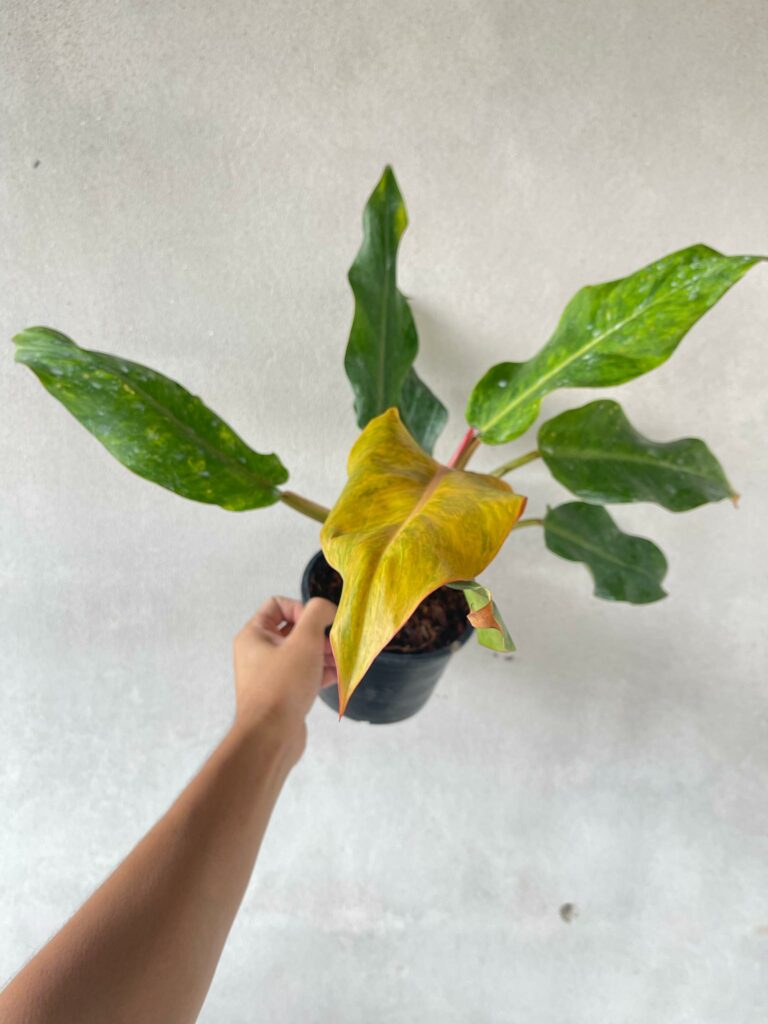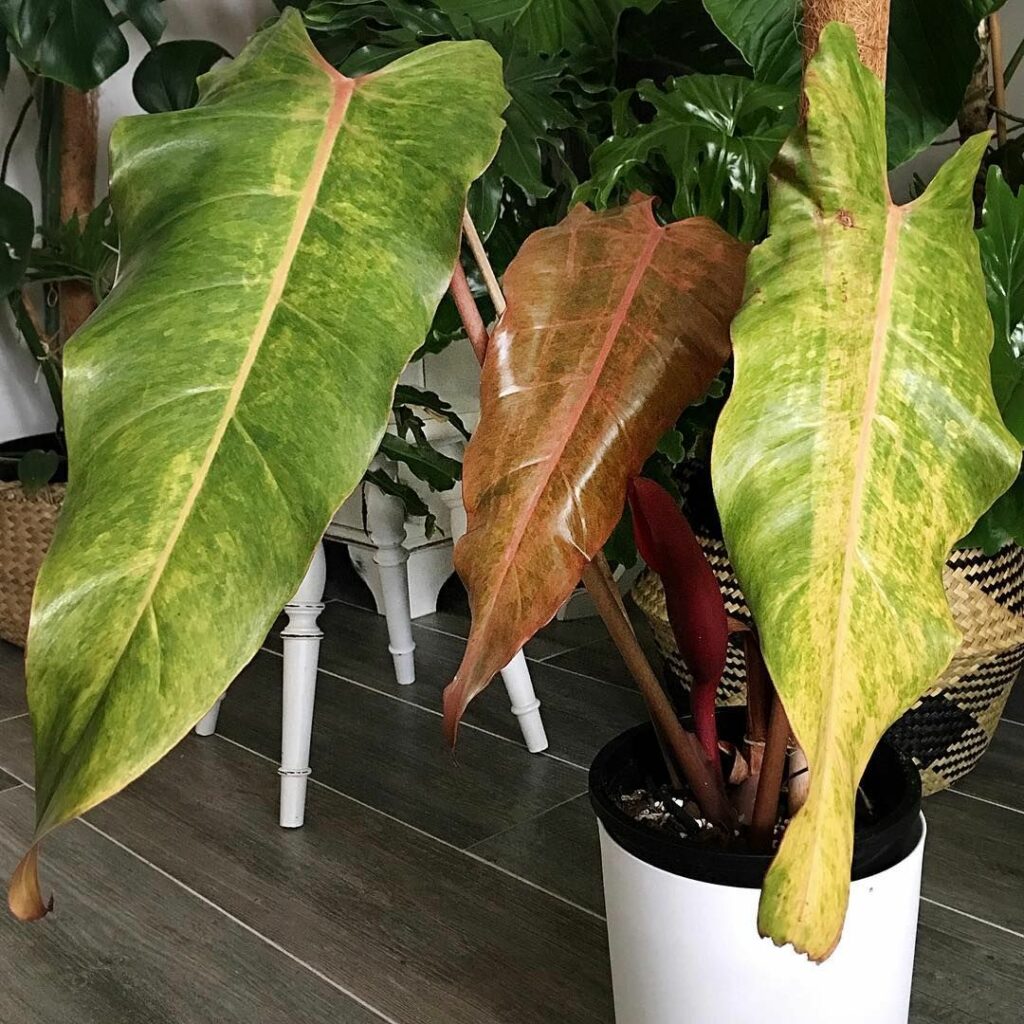What is Philodendron Orange Marble?
Philodendron Orange Marble is a rare and stunning variety of Philodendron, a genus of tropical plants known for their lush foliage and easy-care nature. This particular variety is prized for its striking, variegated leaves that feature a mix of orange, yellow, and green hues. As a popular houseplant, it adds a vibrant touch of nature to any indoor space.
Why is it unique?
What sets Philodendron Orange Marble apart from other Philodendron varieties is its distinct coloration and variegation pattern. The leaves showcase a marble-like effect, with each leaf displaying a unique mix of colors, creating a visually stunning appearance. This beautiful foliage makes it a highly sought-after plant among houseplant enthusiasts and collectors.

Origin and habitat
Where does it come from?
Philodendron Orange Marble is native to the tropical rainforests of Central and South America. Like other Philodendron species, it thrives in the understory of the forest, where it receives dappled sunlight and is protected from harsh weather conditions.
Natural habitat conditions
In its natural habitat, the Philodendron Orange Marble enjoys high humidity, warm temperatures, and well-draining soil. These conditions promote healthy growth and help maintain the plant’s vibrant coloration. To successfully cultivate this tropical beauty indoors, it’s essential to replicate these conditions as closely as possible.
Growth and appearance
Growth habit
The Philodendron Orange Marble is a climbing plant, using aerial roots to attach itself to nearby trees or structures for support. As a houseplant, it’s common to provide a moss pole or trellis for the plant to climb, which can also help to maintain its compact, bushy appearance.
Foliage
The most striking feature of the Philodendron Orange Marble is its large, heart-shaped leaves. These leaves are adorned with unique variegation patterns, boasting a mix of orange, yellow, and green shades. As the plant matures, the foliage becomes more pronounced, making it an even more stunning addition to your indoor plant collection.
Caring for your Philodendron Orange Marble
Light requirements
Philodendron Orange Marble prefers bright, indirect light, which helps to maintain its vibrant leaf coloration. Direct sunlight can cause the leaves to scorch and lose their characteristic variegation. Place your plant near a window with filtered light or provide it with artificial light sources if natural light is insufficient.
Watering needs
Like most Philodendron varieties, the Orange Marble enjoys consistently moist soil but is sensitive to overwatering. It’s essential to let the top inch of soil dry out between waterings to prevent root rot. The frequency of watering will depend on factors such as light, temperature, and humidity, so it’s important to monitor your plant’s moisture levels closely. To learn more about the proper watering techniques for Philodendron plants, you can refer to our extensive guide
Soil and potting
A well-draining, peat-based potting mix is ideal for the Philodendron Orange Marble. Ensure that the pot you choose has drainage holes to prevent water from sitting at the bottom, which can lead to root rot. Repot your plant every 2-3 years or as needed, depending on its growth rate and root development.
Fertilization
Fertilize your Philodendron Orange Marble with a balanced, water-soluble fertilizer every 4-6 weeks during the growing season (spring and summer). Reduce the frequency to once every 8-10 weeks during fall and winter, when the plant’s growth slows down.
Pruning and propagation
Prune your Philodendron Orange Marble to maintain its shape and size by trimming back leggy or overgrown stems. You can propagate the plant from stem cuttings taken during pruning. Simply place the cutting in water or moist soil, and it should develop roots within a few weeks.
Common issues and solutions
Pests
Philodendron Orange Marble can be susceptible to common houseplant pests such as mealybugs, spider mites, and aphids. Inspect your plant regularly for any signs of infestation and treat promptly with insecticidal soap or neem oil. Maintaining adequate humidity and air circulation can also help to deter pests.
Diseases
Overwatering and poor drainage can lead to root rot and fungal infections in your Philodendron Orange Marble. Ensure that you allow the soil to dry out between waterings and provide a well-draining potting mix to prevent these issues. If you notice any signs of disease, remove affected leaves and treat with an appropriate fungicide.

Conclusion
The Philodendron Orange Marble is a stunning and unique houseplant that can add a touch of tropical beauty to any indoor space. With proper care, attention to its light, watering, and humidity needs, this vibrant plant can thrive and become a prized addition to your collection.
FAQs
- How often should I water my Philodendron Orange Marble?
Water your Philodendron Orange Marble when the top inch of soil feels dry. The frequency will depend on factors such as light, temperature, and humidity, so it’s important to monitor your plant’s moisture levels closely.
- Can Philodendron Orange Marble tolerate low light conditions?
While this plant can adapt to lower light levels, its vibrant coloration and variegation may become less pronounced. For the best results, provide bright, indirect light.
- Is the Philodendron Orange Marble toxic to pets?
Yes, like other Philodendron varieties, the Orange Marble contains calcium oxalate crystals, which can be toxic to pets if ingested. Keep your plant out of reach of curious pets.
- How can I encourage more vibrant leaf coloration in my Philodendron Orange Marble?
Providing your plant with bright, indirect light and proper care will help maintain its vibrant leaf coloration. Ensuring that it receives adequate humidity and regular fertilization will also contribute to healthier, more colorful foliage.
- Can I grow my Philodendron Orange Marble outdoors?
If you live in a region with a warm, humid climate (USDA zones 10-11), you can grow your Philodendron Orange Marble outdoors. However, be sure to provide it with a sheltered location that receives dappled sunlight to prevent sunburn on its leaves.

